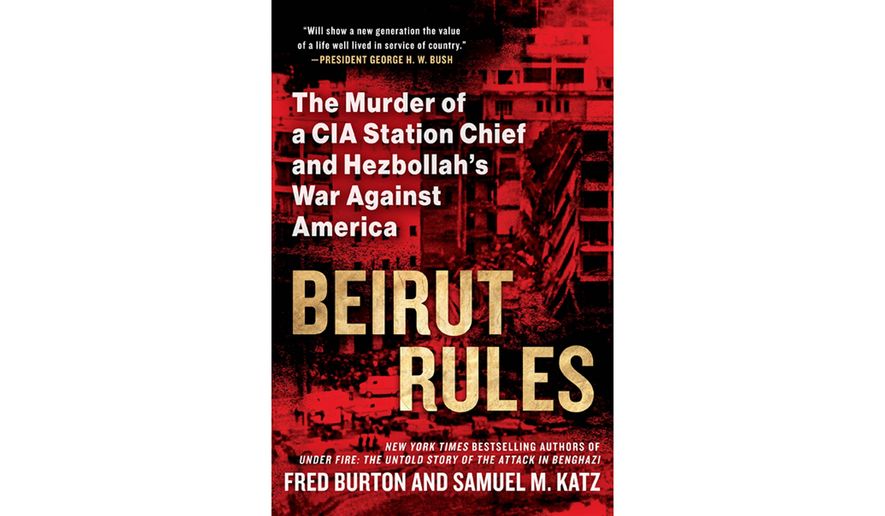OPINION:
BEIRUT RULES: THE MURDER OF A CIA STATION CHIEF AND HEZBOLLAH’S WAR AGAINST AMERICA
By Fred Burton and Samuel M. Katz
Berkley, $28, 400 pages
On March 16, 1984, William Buckley, the CIA station chief in Beirut, Lebanon, was kidnapped by Hezbollah operatives just as he had left his apartment building at 6:45 am and started driving his car to his office at the United States embassy compound, a two-minute drive away. The two cars driven by the Hezbollah kidnappers quickly blocked Mr. Buckley’s car and their operatives overwhelmed him with their firearms and hurled him into one of their cars, driving him to their hidden place of captivity. Mr. Buckley had been in his position since June 1983, and contrary to standard security practice, he was not accompanied by an embassy-provided driver or bodyguard. Mr. Buckley reportedly died in Hezbollah captivity in June 1985, despite the numerous measures the United States had employed to attempt his rescue.
Taking this high-profile kidnapping as its central focus, this book is a dramatic and engaging account of the American backchannel intelligence and military efforts to help restore order to Lebanon’s protracted Hobbesian civil war, with the Iranian- and Syrian-backed Hezbollah’s Shi’ite insurgency the primary antagonist.
Hezbollah’s insurgency took the form of systematically kidnapping and assassinating Westerners in Lebanon, whether academics, United Nations officers, Christian humanitarian aid officials and journalists. During Mr. Buckley’s brief tenure at the U.S. embassy, Hezbollah also organized two spectacular truck-driven suicide bombing attacks in Beirut on Oct. 23, 1983, with the first explosion killing 241 U.S. Marine Corps personnel at their barracks by the Beirut Airport, and the second killing 58 French peacekeeping personnel and six civilians.
The authors are well-placed to write this account of U.S. covert involvement in Lebanon’s violent civil war. Fred Burton, a former State Department counterterrorism deputy chief and Diplomatic Security Service (DSS) agent, had served in the region during the period covered in the book. Because of his insider knowledge of many of the U.S. military and intelligence personalities whose activities are recounted in the book, several dozen passages were redacted by the U.S. government’s censor. This can be annoying to a reader, but it’s a small price to pay for an informed account. Samuel Katz is a veteran writer on Middle Eastern military and terrorism issues.
Imad Fayez Mughniyeh, who became a central terrorist mastermind in Hezbollah, figures prominently in the book, particularly given his involvement in Mr. Buckley’s abduction. As the authors explain, Mughniyeh, born into the poor Shi’ite Mughniyeh clan in northern Lebanon in December 1962, had made the circuitous path from joining the Sunni-based Palestinian Fatah guerrilla army in Lebanon at age 14, where he rose to become a prominent member of its elite Force 17 bodyguard protection unit, to becoming a member of Iran’s Revolutionary Guard in Lebanon, where he became one of its, and Hezbollah’s, chief terrorist operations masterminds.
Mughniyeh’s greatest innovation, the authors explain, was his introduction of the tactic of suicide martyrdom operations to the Lebanese battlefield by adapting the Iranian “Shiite notion of self-sacrifice and paradise” to his “own personal ambitions [to] ’diabolically rewrite’ the battle for Lebanon’s existence” by deploying susceptible operatives to kill themselves by detonating their bomb-laden vehicles against their adversaries.
Among the numerous terrorist operations he had organized, recounted in the book, are the suicide truck bombing of the Israeli military headquarters in Tyre on Nov. 11, 1982 (which killed 75 Israeli soldiers, border policemen and Shin Bet security agents); and the bombing of the U.S. embassy building in Beirut on April 18, 1983, which killed 63 people, including 17 Americans, among them Robert Ames, the CIA’s top Middle East analyst, and Kenneth Haas, the CIA’s station chief (and Mr. Buckley’s predecessor).
Mughniyeh was also implicated in organizing the March 17, 1992, bombing of the Israeli embassy attack in Buenos Aires, Argentina, which killed 29 people, as well as the July 1994 bombing of the Jewish cultural building in the same city, which killed 85 people.
Mughniyeh, working on behalf of his Hezbollah, Iranian and Syrian handlers, also targeted Lebanese politicians who were considered “too independent” of their control. In the most notable assassination, on Feb. 14, 2005 a Mughniyeh operative detonated himself and his bomb-laden truck past a motorcade belonging to Rafiq Hariri, an influential and billionaire Sunni former Lebanese prime minister, in West Beirut, with Mr. Hariri and 20 other people killed in the blast. (Although not discussed in the book, Hariri’s son, Saad Hariri, is Lebanon’s current prime minister, and likely extremely wary of Hezbollah’s influence in the country.)
With American and Israeli intelligence services in hot pursuit of Mughniyeh, the authors detail how he was finally killed, reportedly by Israeli undercover operatives, in the outskirts of Damascus, Syria, on the night of Feb. 12, 2008, when he turned his car’s ignition key, which detonated the bomb that had been planted inside it.
This book is an indispensable guide to understanding Lebanon’s religious conflicts and the nefarious roles played by Iran and Syria in that country, beginning in the 1980s. It shows how Lebanon’s instability handicaps Western countries — particularly the United States — in efforts to mitigate the region’s perpetual conflict.
• Joshua Sinai is a senior analyst at Kiernan Group Holdings (KGH), in Alexandria, Va.




Please read our comment policy before commenting.